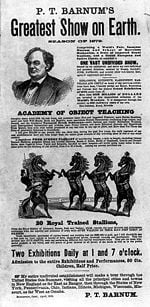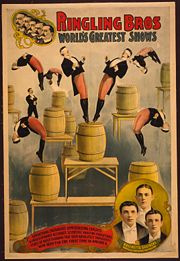Circus World Museum
The Circus World Museum is a large museum complex in Baraboo, Wisconsin, in the U.S., devoted to circus-related history in America. The museum, which features not only circus artifacts and exhibits, but also hosts daily live circus performances throughout the summer. The museum is owned by the Wisconsin Historical Society and operated by the non-profit Circus World Museum Foundation. The Museum was a major participant of the Great Circus Parade held from 1985 to 2005. The museum was opened to the public in 1959.
Baraboo, Wisconsin, was home to the Ringling Brothers Circus, the largest surviving circus company in the United States. The Circus World Museum was established in 1954 as a museum for the Ringling Brothers Circus and circus history in general.
The collection includes 200 historical circus wagons from around the world and the Museum is home to The Robert L. Parkinson Library and Research Center. The Museum also contains a variety of archive materials as well as books and journal articles, including: More than 10,000 original posters and newspaper advertisement, about 4,500 band foils with some sound files, manuscripts, photographs, correspondence, and artifacts. The library holds the most complete business records of circus operations including ledgers, contracts, reports, and correspondence; such materials are valuable primary sources for historians to study the emergence of a global entertainment industry. The library also holds information on 2,800 circuses in the U.S., and about 300,000 performers and circus professionals.
History
Circus World Museum is located in Baraboo, Wisconsin, home to the Ringling Brothers and the first performance of the Ringling Brothers Circus. The circus expanded quickly, touring cities across the United States each summer, but Baraboo remained the circus's headquarters and wintering grounds until 1917, when the Ringling Brothers Circus combined with the Barnum and Bailey Circus, which the Ringling Brothers had bought out in 1908. The combined entity, Ringling Bros. and Barnum & Bailey Circus, was very successful and is the largest surviving circus company in the United States.
The museum also commemorates a number of other circuses formerly based in Wisconsin.
In 1954, John M. Kelley, a former attorney for the Ringling Brothers, developed the Circus World Museum with the intent of forming a museum of the Ringling Brothers Circus and circus history in general. By this time the popularity of circuses and other live shows was declining greatly in favor of new media, such as television. After an initial period of organization and fundraising, the museum acquired a large site in Baraboo that included the former wintering grounds of the Ringling Brothers Circus. This site was deeded to the Wisconsin Historical Society to be used as the museum's location and Circus World Museum opened to the public on July 1, 1959.
Charles Philip "Chappie" Fox (May 27, 1913–September 12, 2003) was a circus historian and philanthropist born in Milwaukee, Wisconsin, who greatly expanded the Circus World Museum and helped found the Great Circus Parade in Milwaukee.
Fox took over the tiny museum in 1960, and began to collect and restore antique circus wagons. These wooden wagons had been built in the late nineteenth and early twentieth century, and lay in disrepair across the United States and Europe. Today, the museum owns over 200 of these wagons.
In 1963, Fox and Ben Barkin, under the sponsorship of the Schlitz Brewing Company, began the Great Circus Parade.
From 1992 to 2003, there were two wagon carvers named Rick King and Cap Jacobs. In their 11 years they restored almost all the wagons at the site, loaded the train, and helped in the daily parade. Rick King also drove the model T ford in the daily parade around the grounds.
Ringling Brothers Circus
The Ringling Brothers Circus was a circus founded in the United States in 1884 by seven Ringling brothers, Albert (1852-1916), August (1854-1907), Otto (1858-1911), Alfred T. (1862-1919), Charles (1863-1926), John (1866-1936), and Henry (1869-1918). The circus began in 1884 in Baraboo, Wisconsin using the title "Yankee Robinson and Ringling Brothers," the only time the Ringlings ever gave themselves second billing. It was a small circus at first, conveyed by wagons, and differed little from scores of other little shows that transversed limited geographic areas.
By the late 1880s, however, the circus had established itself as one of the largest and best-run circuses in the country. John Ringling served as the advance man and Charles Ringling assumed the role of the manager. True to the typical hyperbole of the day, the official title of the circus was the "Ringling Brothers United Monster Shows, Great Double Circus, Royal European Menagerie, Museum, Caravan, and Congress of Trained Animals."
What distinguished the Ringling Brothers Circus from others was its honest and fair attitude toward the public. Unlike other small circuses of the time, Ringling Brothers would not allow ticket sellers to short change customers, nor did they allow games of chance such as Three Card Monte and shell games on their lots. This reputation for clean dealing and good value brought them success, and soon they were able to make the leap into the ranks of railroad circuses.
The Robert L. Parkinson Library and Research Center
The Robert L. Parkinson Library and Research Center is a research facility of the museum and its collection specializes in circuses, particularly those located in the U.S., and circus history. The collection includes archival materials such as rare photographs from 1850s to the present, posters, manuscripts, artifacts as well as books. It covers information sources approximately from 1793 to the present.
The collection includes information sources on: 2,800 circuses in the U.S., and files about 300,000 circus performers, trainers, and circus professionals; 4,500 band folios; thousands of trade journals, manuscripts; audio files; more than 10,000 original historical posters and newspaper advertisement. The library also holds the most complete circus business records of circus operations including ledgers, contracts, reports, and correspondence.
In 1991, the facility was named after Robert L. Parkinson, the director of the library for twenty six years.
Exhibits
Circus World Museum encompasses several buildings that hold numerous exhibits on circus history.
Ringlingville consists of the remaining buildings of the original wintering grounds of the Ringling Brothers Circus, a National Historic Landmark[1]. Buildings in Ringlingville include the Ring Barn, Elephant House, Animal House, Baggage Horse Barn, Winter Quarters Office, and Wardrobe Department. Tours of Ringlingville present information on the history of the Ringling Brothers Circus, as well as offering behind the scenes glimpses into the efforts taken by the circus while preparing for shows.
The Irvin Feld Exhibit Hall is the museum's largest building and houses exhibits on the history of the Ringling Brothers Circus, as well as other exhibits relating to general aspects of circuses and circus history.
The Hippodrome is a permanent big-top which houses the museum's daily circus and magic show performances.
The W.W. Deppe Wagon Pavilion houses a collection of fifty restored antique circus wagons.
The C.P. Fox Wagon Restoration Center is used by the museum to refurbish Circus Wagons and visitors to the building can view in wagon restorations that are in progress.
Great Circus Parade
The Great Circus Parade, which featured historic circus wagons from the Circus World Museum, was held in Milwaukee in 1963 and subsequently in various cities between 1985 and 2005, primarily Milwaukee (1985-2003) and Baraboo, Wisconsin (2004-2005). When held in Milwaukee, the parade entailed a two-day journey by train across Wisconsin, from Baraboo to Milwaukee, making brief stops at cities along the way. An encampment on Milwaukee's lake front allowed visitors to view the circus wagons up close, take elephant, camel, and zebra rides, and view historical circus artifacts. The parade itself took a three-mile route through downtown Milwaukee. Although the parade is presently not running, it is slated to return to Milwaukee in 2009.[2]
See also
- Ringling Brothers
- Circus
Notes
- ↑ NPS, National Historic Landmark. Retrieved January 13, 2009.
- ↑ Wisconsin Historical Society, "Great Circus Parade to Return to Milwaukee." Retrieved January 13, 2009.
ReferencesISBN links support NWE through referral fees
- Albrecht, Ernest J. The New American Circus. Gainesville: University Press of Florida, 1995. ISBN 9780813013640.
- Bonheur, Rosa. Circus World Museum Poster Collection. 1841.
- Circus World Museum (Baraboo, Wis.), and Charles Philip Fox. Horse Drawn Wagon Collection at the Circus World Museum. Baraboo, WI: Great Circus Parade, 1994.
- Circus World Museum Film and Video Collection. 1906.
- Fellows, Dexter William, and Andrew A. Freeman. This Way to the Big Show: The Life of Dexter Fellows. New York: Viking Press, 1936.
- Croft-Cooke, Rupert, and Peter Cotes. Circus: A World History. New York: Macmillan Pub. Co, 1977.
- Guernsey's (Firm). The Circus World Collection of Important Circus Artifacts and Carrousel Carvings: Encompassing the Collections of Charles Philip Fox, Robert Clarke, and William Donahue, Seventh Regiment Armory, New York City, February 16 & 17, 1985. New York, N.Y.: Guernsey's, 1985.
- Museum of the City of New York. Circus Collection. 1821.
- Ringling Museum of the Circus, and Mel Miller. Ringling Museum of the Circus; The Collection and Its Relation to the History of the Circus. 1963.
- Speaight, George. A History of the Circus. London: Tantivy Press, 1980. ISBN 9780498024702.
- Stoddart, Helen. Rings of Desire: Circus History and Representation. Manchester: Manchester University Press, 2000. ISBN 9780719052347.
External links
All links retrieved December 10, 2023.
Credits
New World Encyclopedia writers and editors rewrote and completed the Wikipedia article in accordance with New World Encyclopedia standards. This article abides by terms of the Creative Commons CC-by-sa 3.0 License (CC-by-sa), which may be used and disseminated with proper attribution. Credit is due under the terms of this license that can reference both the New World Encyclopedia contributors and the selfless volunteer contributors of the Wikimedia Foundation. To cite this article click here for a list of acceptable citing formats.The history of earlier contributions by wikipedians is accessible to researchers here:
The history of this article since it was imported to New World Encyclopedia:
Note: Some restrictions may apply to use of individual images which are separately licensed.


